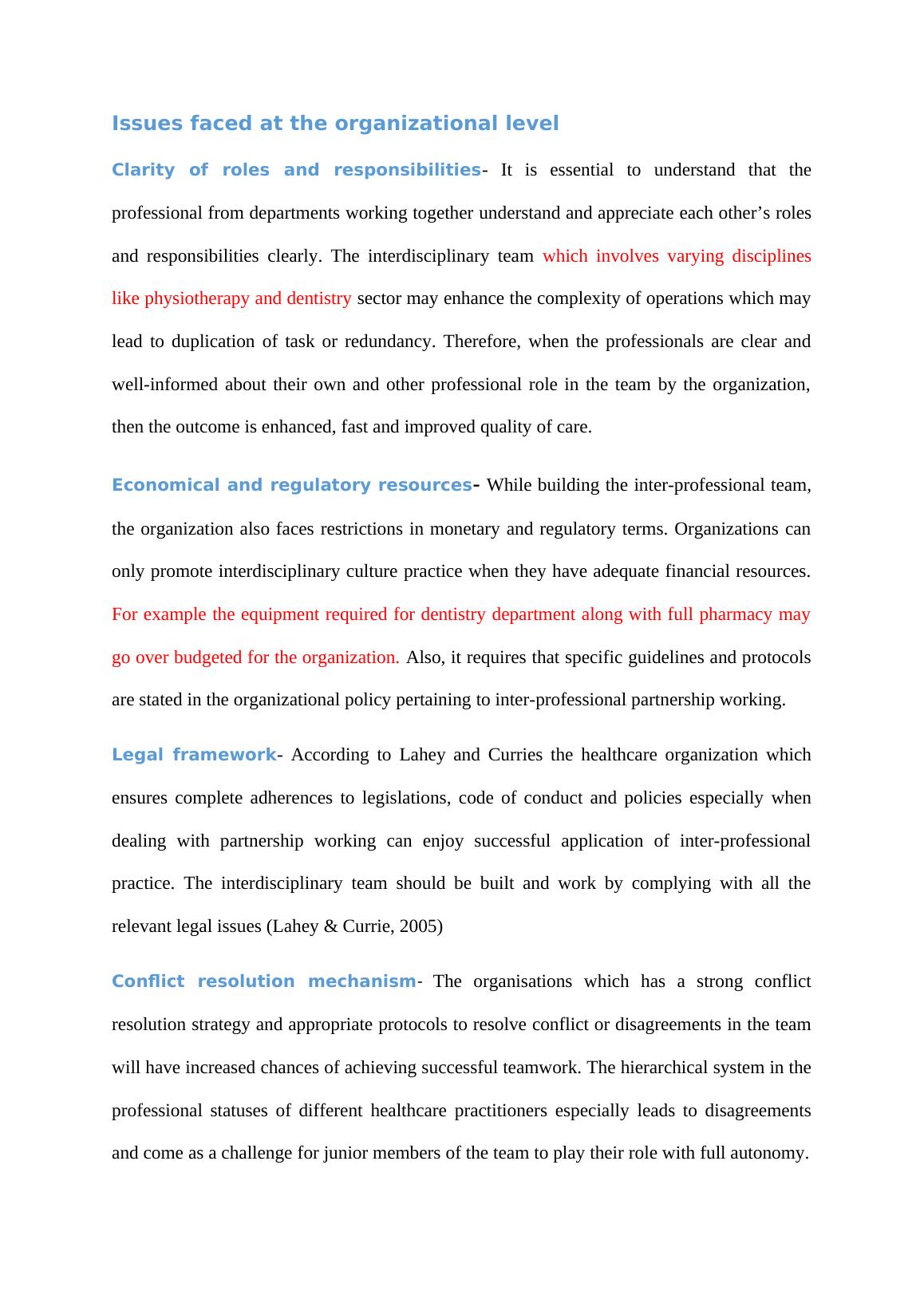Inter-Professional Healthcare: A Case Study
Added on 2021-06-16
9 Pages2388 Words191 Views
IntroductionInter-professional healthcare involving different disciplines like nurses, doctors, pharmacists,dentist, physiotherapist, etc. has become increasingly important in recent times with peopleshowing up with multiple and complex health issues. The assignment is prepared tounderstand the different aspects and issues of inter-professional practice. Several issues areconfronted at different levels of inter-professional care. The assignment critically evaluatesthe key professional issues that underpin contemporary inter-professional health care practiceat organizational, team and individual level. Lastly, the assignment is concluded with keyfindings.DiscussionNijagal et al has provided evidence that when professional from different expertisecollaborate with each other for inter-professional healthcare practice, it maximizes thedelivering best possible care to the service user [ CITATION Nij15 \l 1033 ]. The cumulativeparticipation and feedback from different from several experts from different specializationsbecomes a source of excellent service provision. Therefore, as Babiker et al. stated thatenhanced services can be made available to the service user through inter-professionalworking from organizations [ CITATION Bab141 \l 1033 ]. But the healthcare professions workon an autonomous relationship between the professional and service user. This relationship isessential in providing care but it is challenged by in many aspects of collaboration andpartnership working.There are various professional issues that underpin contemporary inter-professional health care practice including, nursing, medicine, dentistry, pharmacy, etc. atdifferent levels.

Issues faced at the organizational levelClarity of roles and responsibilities- It is essential to understand that theprofessional from departments working together understand and appreciate each other’s rolesand responsibilities clearly. The interdisciplinary team which involves varying disciplineslike physiotherapy and dentistry sector may enhance the complexity of operations which maylead to duplication of task or redundancy. Therefore, when the professionals are clear andwell-informed about their own and other professional role in the team by the organization,then the outcome is enhanced, fast and improved quality of care. Economical and regulatory resources- While building the inter-professional team,the organization also faces restrictions in monetary and regulatory terms. Organizations canonly promote interdisciplinary culture practice when they have adequate financial resources.For example the equipment required for dentistry department along with full pharmacy maygo over budgeted for the organization. Also, it requires that specific guidelines and protocolsare stated in the organizational policy pertaining to inter-professional partnership working.Legal framework- According to Lahey and Curries the healthcare organization whichensures complete adherences to legislations, code of conduct and policies especially whendealing with partnership working can enjoy successful application of inter-professionalpractice. The interdisciplinary team should be built and work by complying with all therelevant legal issues [ CITATION Wil05 \l 1033 ]Conflict resolution mechanism- The organisations which has a strong conflictresolution strategy and appropriate protocols to resolve conflict or disagreements in the teamwill have increased chances of achieving successful teamwork. The hierarchical system in theprofessional statuses of different healthcare practitioners especially leads to disagreementsand come as a challenge for junior members of the team to play their role with full autonomy.

Organisational hierarchies – The hierarchical structure of health care organisation hasbeen as an obstruction in the proper functioning of the team where all members’ views areacknowledged. For example nurses and pharmacits are seen below in the hierarchy ascompared to the other professions like medicine and dentistry.Training and orientation- According to Irvine et. al, the organizations that providesuitable training to their professional especially for inter-professional collaboration. The newmembers should be oriented for the same [ CITATION IRV02 \l 1033 ].Issues faced at the team levelShared purpose- according to D’amour and Oandasan, it is important that all the teammembers belonging to different profession must agree on a well-defined and clearly statedgoal. When there is a common purpose defined between the team, it will help all theprofessionals to move in the same direction and perform their role [ CITATION Dam05 \l 1033 ].Leadership clarity- According to Mitchell et al., leadership is one of the core base of theteam-based health care. When the members of the team have certainty with the leadershipand clarity of roles, the functioning becomes smooth without any conflicts. A well-led teamwill be able to remain guided and motivated to provide the best possible care for the patient [CITATION Mit12 \l 1033 ].Size of the team- It is important that adequate members come to collaborate with eachother as an interdisciplinary team so that adequate professional are available to play theirrespective role. If a team is too small, it will build the pressure of workload on the members

End of preview
Want to access all the pages? Upload your documents or become a member.
Related Documents
Collaborative Nursing: Recommendations for Team Charter and Communication Strategieslg...
|8
|1753
|256
Inter Professional Conflict in Nursinglg...
|7
|1641
|437
Healthcare Professional Skillslg...
|13
|2903
|189
Inter-Professional Collaboration in Health Care: A Reflective Accountlg...
|15
|4491
|119
Supporting the Individual Journey through Integrated Health and Social Carelg...
|12
|3802
|73
Health and Social Care in Practice Assignment - Allied Healthcarelg...
|11
|4064
|119
